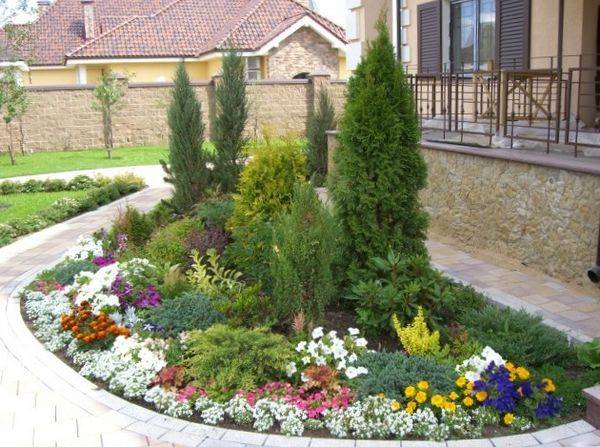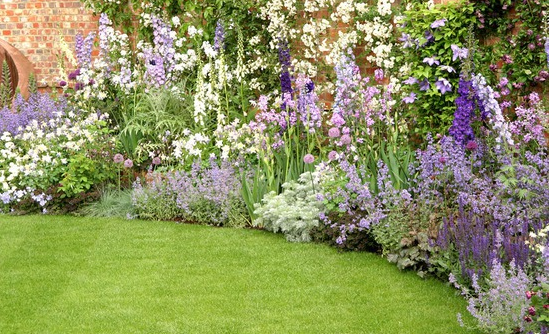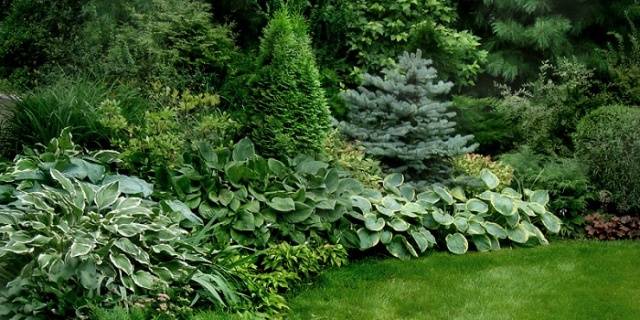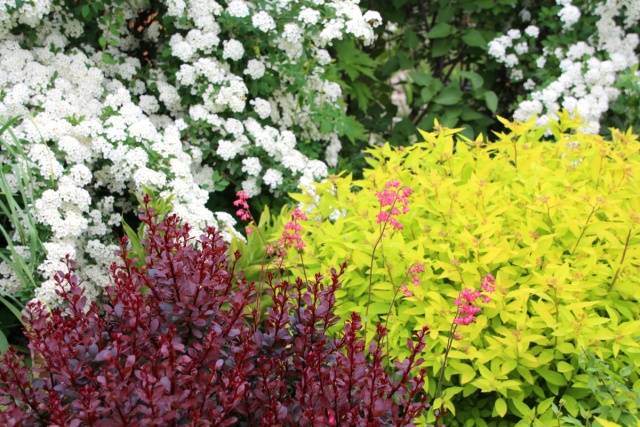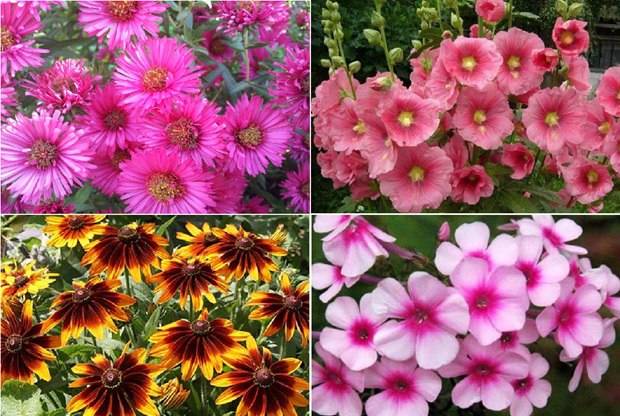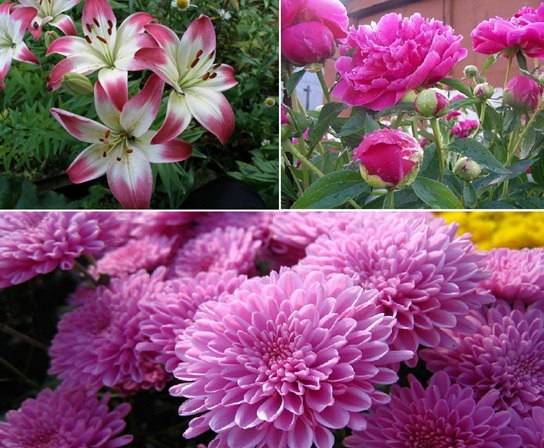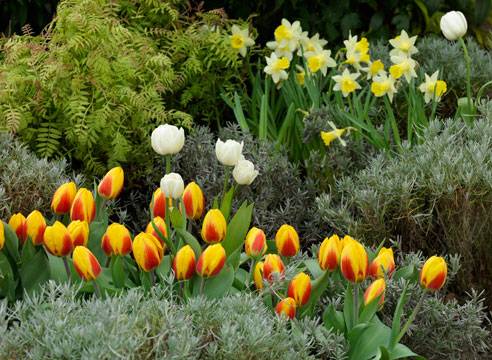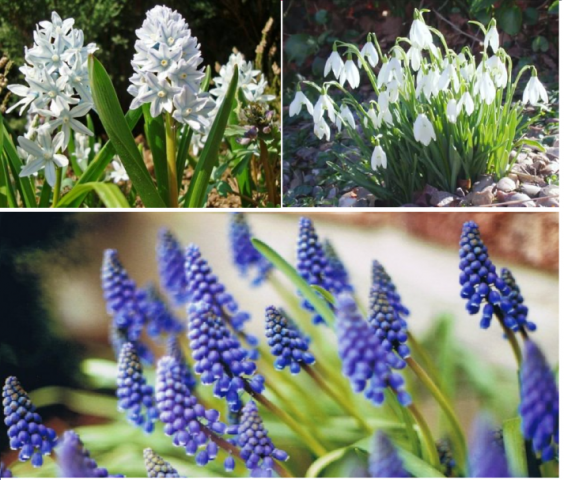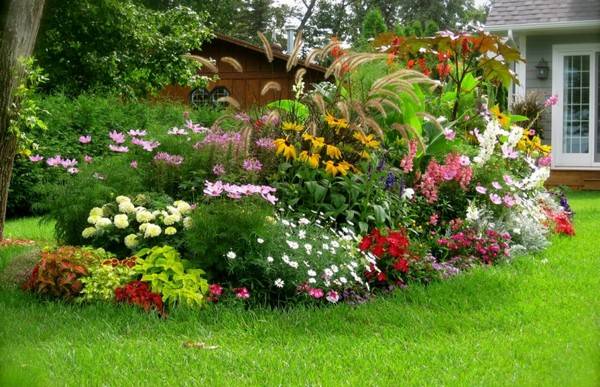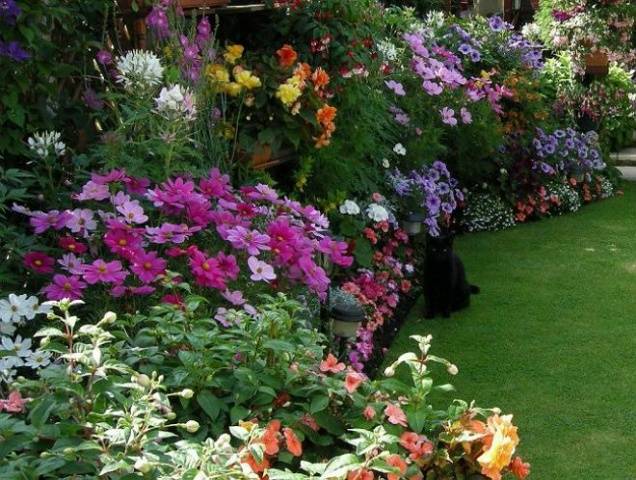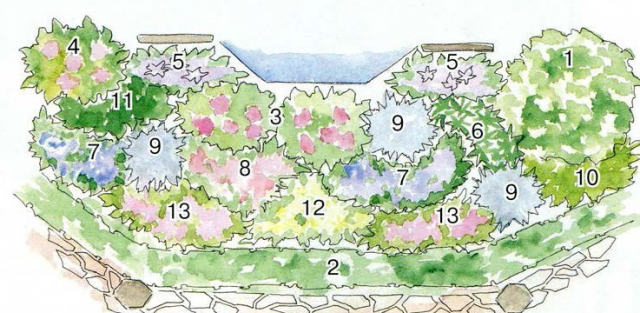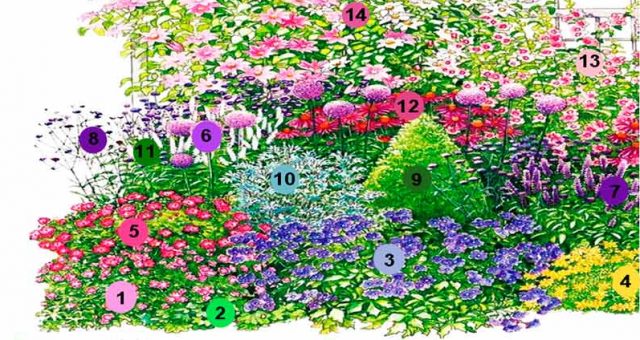Content
Mixborders are flower beds on which ornamental plants that complement each other are planted. They can become a decoration of a park, a backyard landscape, a garden. Perennial and annual herbaceous plants, flowers, shrubs and even small trees can be used to fill flower beds. Mixborders from perennials are especially popular, because from year to year they are able to delight with their beauty without requiring special care.
There are special ready-made planting schemes developed by landscape designers with flower garden zoning and plant selection. Even a novice gardener can implement such pre-drawn mixborder schemes.
Important points when planning
A beautiful mixborder is a harmonious composition of plants planted in a specific order in compliance with some general rules:
- Mixborders can be single-sided or double-sided... One-sided flower beds are placed along footpaths or paths, behind them there may be a wall of a building or a fence. A double-sided flower garden assumes the presence of paths or viewpoints from both sides. An example of a one-sided and two-sided mixborder is shown in the photo:
- When creating a one-sided mixborder, tall plants and shrubs are planted in the background, undersized or creeping perennials, and lawn grass in the foreground.
- When creating a double-sided mixborder, tall plants should be planted in the middle lane, and low-growing perennials should be placed closer to the edge of the flower garden.
- When placing perennials in one flower garden, it is necessary to use the multi-tiered principle. In this case, the plants will not shade, drown out each other and will fully show their beauty.
- Flower arrangements, like paintings, should be viewed at some distance in order to appreciate all their charm, which is why it is recommended to place mixborders at some distance from the point of view. The remoteness of tall plants should be no less than their height.
- Mixborders from perennials have a peculiarity - in the first years after the device, the composition is not lush enough, since the plants must grow. At this time, it can be supplemented with annual flowers.
- Placing perennials on flower beds, you must remember that they will grow over time, so you do not need to plant the plants too tightly to each other.
- Mixborders can be created with a certain semantic load, for example, placing a flower garden at the entrance to a building or on the bank of an artificial reservoir can favorably emphasize the landscape of the site and the design, architecture of the building.
The shapes of mixborders can be different: regular, curved, intricate. So, landscape designers recommend placing compositions at a certain angle, for a better view from anywhere in the garden. An example of such a flower garden can be seen in the photo:
Plant selection
Having decided on the location and shape of the mixborder, you should think about its filling. When choosing perennials, some nuances must be taken into account:
- Plants in the same flower garden must have the same photosensitivity, shade-loving and light-loving crops should not be planted nearby. The choice of certain plants depends on the illumination of the area on which the mixborder will be located.The same rule applies when choosing plants, taking into account moisture and soil composition;
- The root system of all plants should be closed, extending vertically downward... Plants with a creeping and horizontally spreading root system will eventually destroy their "neighbors".
- Blooming perennials should be selected in such a way that periods of their flowering smoothly replaced each other... This will produce a continuous flowering mixborder. You should also exclude the situation when, after wilting, the plant loses its decorative qualities, it must be cut off, and the cut site remains an "empty spot" on the flower garden. In this case, perennials of the lower tier with a later flowering period or annuals can be used as a cover;
- You can make a beautiful mixborder from perennials using plants with a decorative leaf... So, the composition can include geykhera, hosts, ferns.
Thus, when choosing plants for mixborders, it is necessary to take into account their tallness, the type of root system, the need for sunlight, the nutritional value of the soil and moisture. Of course, do not forget about the color of plants. So, flower beds can be:
- contrasting, with a combination of red and green, purple and yellow. Such compositions are more suitable for creating compact, low mixborders;
- monochrome... To create them, flowers of calm, delicate shades of pink, yellow, purple are used;
- variegatedcombining various bright colors. An example of a motley mixborder can be seen below in the photo:
When creating a mixborder from shrubs and perennials, the following are popular:
- Barberry and spirea differ in unusual color of leaves and show their decorative qualities all season. Trimming boxwood can create beautiful green barriers or unique landscape figures.
- English aster, mallow, rudbeckia, phlox and some other tall flowers can be used to create the skeleton of an exposition. You can see them in the photo:
- Among plants of medium height, for drawing up the second line of the mixborder, one should prefer lilies, peonies, chrysanthemums... Their height will be roughly from half a meter to a meter.
- Perennials up to half a meter are most popular when creating mixborders. They are suitable for both one-sided and two-sided compositions. Among these colors, multi-colored primroses, incense, tulips, daffodils.
- Low-growing flowers, up to 25 cm high, should also be included in mixborders. As a rule, they are used for bordering paths and paths. Landscape designers often use for this purpose pushkinia, galanthus, muscari and some other plants.
All of these perennials have a modest, upright root system and can complement each other in flower beds. They bloom at different times, some of them can grow in the shade, some prefer sunny areas of the land, so each gardener must combine perennials himself in accordance with existing conditions and personal wishes.
Stages of creating a mixborder
The creation of a composition of perennials must be treated with special responsibility, because the result of the work should "please the eye" subsequently for several years. Experts recommend creating mixborders in stages, performing actions in a specific order:
- Before planting perennials, it is necessary to set the shape of the mixborder and prepare the soil. If necessary, you can create a decorative border of stone, wicker.
- Filling the flower garden should start with skeletal plants - undersized trees, shrubs (yew, Bergman pine, conical spruce, barberry), tall flowers. It is recommended to place them without observing symmetry, since in this case the composition will look natural.
- Medium-sized flowers and plants with a decorative leaf (hosta, cineraria) should be planted in the second tier so that, if necessary, they cover the trunks of tall shrubs and the foot of ornamental trees.
- Empty spaces in the composition should be filled with medium and low-growing flowering plants, observing the principle of multi-tiered. They should be planted in groups in order to fully reflect the beauty of the plants.
- If necessary, in the first years after creation, mixborders can be supplemented with annuals. They will add extra freshness, brightness and make the flower garden full.
This will allow you to correctly choose the optimal distances between them.
Ready-made schemes
In order to choose the right decorative perennials for a mixborder, it can take a lot of time and literature for an ordinary gardener, because it is not so easy to find information about the height, root system of a plant, its flowering period and preferences. Comparing information about different plants and choosing “good neighbors” is even more difficult. In this case, professional landscape designers helped to alleviate the situation, who drew up and offered gardeners ready-made mixborder schemes from perennials and the names of flowers, shrubs, trees used in the composition. Photos and diagrams of some of them are given below.
Fragrant flower garden
This mixborder combines tall shrubs and aromatic, flowering perennials... You can create a flower garden on rocky, well-drained soil. Such a composition is one-sided, therefore it should be placed against the wall of a building, a fence. It is perfect for a well-kept, spacious yard or garden near a solid cottage.
Filling a fragrant flower garden should be started by planting an ordinary juniper (3). Do not be limited to one plant, it is preferable to plant 2-3 conifers. Shrub cinquefoil (1) is also the "skeleton" of a flower garden. The plant should not be centered. In contrast to Potentilla, in compliance with conditional symmetry, Ferdinand Coburg's saxifrage should be planted (4). This plant is not flowering, but has beautiful decorative leaves.
The subsequent filling of the flower garden takes place in stages, observing the principle of mono-tiered and conditional symmetry. Plants are placed in groups. Various types of saxifrage are planted under numbers 5, 6, 7, 8, and 9: hybrid, lush, wedge-shaped, paniculate, musky. Pinnate carnation (10) will add delicate colors and a pleasant aroma to the flower garden. The roofing (11) undersized, but very original plant was rejuvenated, which will become the highlight of the mixborder.
It is recommended to bring the Thunberg barberry to the foreground of the composition (2). The plant is a low-growing bushes with a decorative purple leaf.
Thus, many different varieties of saxifrage are used to formulate an aromatic mixborder. These wonderful plants are unpretentious, have a compact root system, bloom for a long time and very beautifully, exuding a pleasant aroma. Barberry in such a flowerbed acts as a beautiful border. Cinquefoil and juniper will add "growth" and chic to the flower garden.
Option for professionals
This ready-made mixborder circuit is one-sided. Such a flower garden can be placed against the wall of a building or, for example, near a fence. To create such a lush composition is quite simple, if you know where to start: the first one should plant a boxwood (9), trimmed, in this case, in the form of a cone. It is not worth placing it in the middle of the flower garden; it is better to shift it to the side to make it look natural.
At some distance behind the boxwood should be planted clematis (14). You can combine red and white varieties of this perennial.Beautiful clematis will be a wonderful backdrop for the flower garden as a whole.
The gap between clematis and boxwood should be filled with medium-sized plants: khatma (13), echinacea (12), ornamental onions (6), verbena (8), Korean mint (11). Will fill the composition with lightness and shade boxwood wormwood (10) with a decorative, silvery leaf.
In the foreground of the mixborder, a fennel grate (7), shrub cinquefoil (5), a majestic geranium (3), an Endress geranium (1), a soft cuff (2) and coreopsis (4) should be planted.
Such a beautiful, lush floral arrangement can be a decoration for a courtyard with buildings in eco, rustic or classic style. To decorate the yard with a large mansion, the mixborder should be expanded and more tall shrubs and ornamental trees should be used.
Flower garden for beginner gardeners
Even a novice gardener can implement such a ready-made scheme. It can be used both one-sided and two-sided. The skeletal plant of the flower garden is a tall mock-orange (1). To the right and to the left of it, it is necessary to arrange peonies (2) and phloxes (3). Lilies (4) and Mexican Ageratum (5) can be used to create the next layer of medium-sized plants. Among the stunted perennials, it is recommended to choose sea lobularia (7), Turkish carnation (8) to create a composition.
Such a wonderful flower garden can be located at the porch, gate, along the paths. The mixborder will bloom constantly from June to September. You can see other examples and schemes of mixborders from perennials, as well as learn some of the nuances of their creation, in the video:
Conclusion
A beautiful mixborder, if desired, can be created by every gardener. To do this, it is not at all necessary to resort to the services of professional designers, since you can use ready-made schemes with the optimal selection of plants. With a little imagination and finding out, analyzing information about various types of perennials, it is easy to independently compose a composition or make changes to ready-made schemes. A beautiful mixborder will always be able to decorate a personal plot, it is advantageous to highlight and emphasize the existing architecture and landscape.

